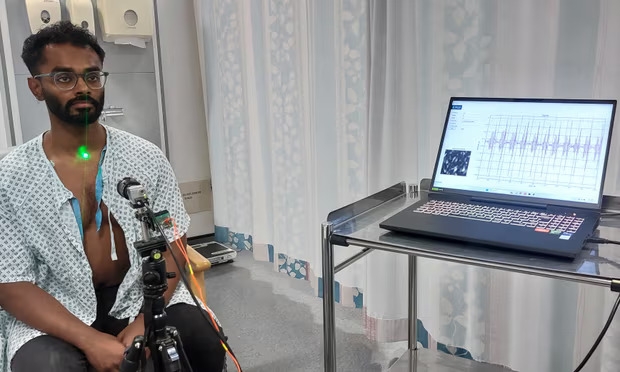Optical Stethoscope
The contactless optical stethoscope, led by Professor Daniele Faccio, is a novel prototype device that combines optical equipment, including a laser and a camera, together with specially trained AI models and software. The Digital Health Validation Lab has been supporting this project through its consulting services, identifying potential targets for clinical applications as well as supporting with the validation of the device’s capabilities.
The Optical Stethoscope
Cardiovascular diseases are the leading cause of death worldwide, underscoring the critical need for early diagnosis. However, lengthy NHS waiting lists for cardiac imaging such as echocardiograms, and the reliance on traditional stethoscope assessments—which require significant clinical experience and are prone to subjective interpretation—create substantial challenges in the timely and accurate detection of these conditions.
About the Project
The contactless optical stethoscope, led by Professor Daniele Faccio, is a novel prototype device that combines optical equipment, including a laser and a camera, together with specially trained AI models and software.
This prototype provides a mechanism to pick up localised sounds generated by subtle movements of the heart, specifically the valves, and can therefore identify potential issues associated with heart function without need for the traditional stethoscope.
A total of 25 patients, including 20 with echo-confirmed valvular disease and five controls, were assessed blindly by the optical stethoscope. The results were then compared to the diagnosis recorded by a clinician with a traditional stethoscope and echo report.
How DHVL Supported this Project
The Digital Health Validation Lab has been supporting this project through its advisory services, identifying potential targets for clinical applications as well as supporting with the validation of the device’s capabilities.
Whilst the contactless optical stethoscope has recently been through a small-scale study looking at the accuracy of recording heart sounds from the neck in individuals with no known heart disease, the DHVL is now supporting the project through the next stage of research. Further studies will determine how well this prototype can detect anomalies in heart sounds compared to gold standard device in use today and help justify referral for further investigation such as an echocardiogram.
Furthermore, this research will contribute and accelerate the creation of a functional device that the DHVL aims to support in its further development through the validation of its usability and usefulness in specific clinical contexts, how it may be deployed in places such as GP clinics and the benefit to doing this.


